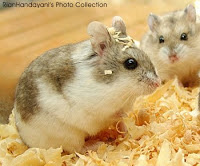Animals
that produce large amounts of offspring depend upon the sheer size of the
litter for the perpetuation of their species. The young mature very quickly and are not
educated, as the parents are usually involved with obtaining their own food and with
reproduction. Should some of the offspring become endangered, the parent will not interfere,
because it is not expected that all the young survive, which is the reason for a large litter.
One animal that produces large litters is the hamster. A female hamster is able to bear
young when she is six weeks to two months old. The gestation period is about 16 days.
Although an average litter size is from five to ten, hamsters commonly have as few as three
or as many as a dozen offspring at a time. Mothers will sometimes eat their own young,
particularly when the number of offspring is large. Females may produce litters up to an age
of about 15 months at monthly intervals. The blind, hairless young begin to grow fur in two
to three days. Their eyes open after about two weeks. After ten days they begin eating solid
food, though the mother will continue to nurse them for about two more weeks. In captivity,
a typical hamster may live for two to three years.
litter for the perpetuation of their species. The young mature very quickly and are not
educated, as the parents are usually involved with obtaining their own food and with
reproduction. Should some of the offspring become endangered, the parent will not interfere,
because it is not expected that all the young survive, which is the reason for a large litter.
One animal that produces large litters is the hamster. A female hamster is able to bear
young when she is six weeks to two months old. The gestation period is about 16 days.
Although an average litter size is from five to ten, hamsters commonly have as few as three
or as many as a dozen offspring at a time. Mothers will sometimes eat their own young,
particularly when the number of offspring is large. Females may produce litters up to an age
of about 15 months at monthly intervals. The blind, hairless young begin to grow fur in two
to three days. Their eyes open after about two weeks. After ten days they begin eating solid
food, though the mother will continue to nurse them for about two more weeks. In captivity,
a typical hamster may live for two to three years.
















